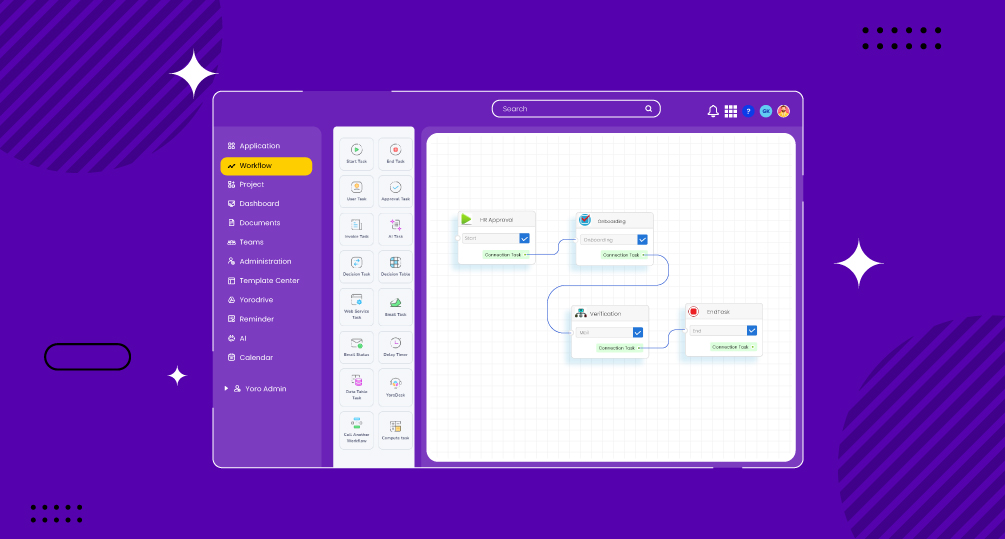Table of Contents
Effective workflow management not only streamlines operations but also fosters better communication and collaboration among team members. In the dynamic landscape of modern business, workflow management is essential for maintaining productivity, ensuring timely project completion, and achieving organizational goals. It involves carefully orchestrating tasks, resources, and timelines to create a seamless process that enhances efficiency and reduces errors.
This article elaborates on workflow management, the importance of workflow management in businesses, features of workflow management tools, and strategies to enhance workflow management.
What is workflow management?
Workflow management is the systematic organization, tracking, and optimization of tasks and activities within a work process. It involves breaking down projects into manageable tasks, assigning resources, creating process maps, and automating repetitive tasks. Effective workflow management ensures tasks are completed efficiently, resources are utilized optimally, and goals are met on time.
By utilizing workflow management software like Yoroflow, businesses can streamline processes, reduce errors, and improve overall productivity, achieving their objectives more effectively. Yoroflow, a no-code platform offers a range of features including a drag-and-drop workflow builder, no-code form designer, approval workflows, custom dynamic reports, rule-based workflows, and customizable workflows. These tools enhance team and task management, significantly boosting workflow management efficiency.
Why is workflow management important for businesses?
Workflow management is essential for businesses because it significantly enhances efficiency, accuracy, and collaboration. By streamlining business processes and automating repetitive tasks, businesses can reduce the time required to complete projects and focus on strategic activities. This not only minimizes human errors but also ensures consistency and quality in task execution.
Enhanced collaboration is another critical benefit, as workflow management tools facilitate better communication and real-time updates among team members. This improved coordination leads to better teamwork and more successful project outcomes.
Efficient resource management is also achieved through optimized task assignments, preventing team member overload, and ensuring resources are used effectively. Additionally, greater transparency provided by workflow management tools allows managers to track progress, identify bottlenecks, and make informed decisions.
Cost savings, scalability, and enhanced compliance are further advantages, as these tools help eliminate inefficiencies, adapt to changing needs, and maintain industry standards. Ultimately, workflow management improves overall productivity, operational efficiency, and employee satisfaction, driving business success.
Features of workflow management tools
Yoroflow, the workflow management tool offers several features that help businesses to streamline operations and enhance workflow management.
- Workflow Automation: Automates processes and repetitive tasks, reducing manual effort and ensuring consistency.
- Collaboration Tools: Facilitates communication and collaboration among team members, often including commenting, file sharing, and real-time updates.
- Visualization and Reporting: Provides visual representations of workflows, progress tracking, and customizable reports for insights into project status and performance.

- Integration Capabilities: Integrates with other tools and platforms like marketing automation tools, CRM, and project management tools to streamline data flow and enhance functionality.
- Notifications and Alerts: Sends notifications and alerts for task updates, deadlines, or changes in workflows to keep team members informed and on track.
- Customizable Workflows: Allows customization of workflows to fit specific business processes and requirements, adapting to varying project needs.

- Access Control and Permissions: Manages user access rights to ensure data security and privacy, controlling who can view, edit, or manage specific tasks or workflows.
- Analytics and Optimization: Offers analytics tools to measure workflow performance, identify bottlenecks, and optimize processes for improved efficiency and productivity.
Strategies to enhance workflow management
Enhancing workflow management involves implementing strategies that improve efficiency, collaboration, and overall effectiveness in how tasks and processes are executed. Here are several strategies to achieve this:
- Set Clear Goals and Objectives: Clearly define project goals, milestones, and expected outcomes. This provides clarity and direction for team members, guiding them in their tasks and decision-making.
- Utilize Workflow Automation: Identify repetitive tasks or processes that can be automated using workflow management tools. Automation reduces manual effort, minimizes errors, and speeds up execution.
- Implement Task Prioritization: Prioritize tasks based on urgency, importance, or dependencies. This helps in focusing efforts on critical activities and ensures that deadlines are met efficiently.
- Enhance Communication and Collaboration: Foster open communication channels among team members. Utilize collaboration tools within workflow management systems to facilitate real-time communication, feedback, and updates.
- Regular Monitoring and Feedback: Monitor workflow progress regularly to identify bottlenecks or inefficiencies. Provide timely feedback to team members to address issues promptly and improve performance.
- Continuous Improvement: Encourage a culture of continuous improvement by regularly reviewing and optimizing workflows. Seek feedback from team members and stakeholders to identify areas for enhancement.
- Integrate Systems and Tools: Integrate workflow management tools with other systems (e.g., CRM, ERP) and productivity tools (e.g., email, calendar) to streamline data flow and enhance functionality.
- Provide Training and Support: Ensure that team members are proficient in using workflow management tools and understand established processes. Offer training and support to maximize tool utilization and effectiveness.
- Adapt to Changing Needs: Stay flexible and adaptable to changes in project requirements, deadlines, or priorities. Modify workflows as needed to accommodate new information or evolving business needs.
Try Yoroflow
Incorporating effective workflow management strategies is crucial for optimizing productivity and achieving operational excellence. By standardizing processes, leveraging automation, and fostering collaboration, teams can streamline workflows and enhance efficiency. With tools like Yoroflow, organizations can simplify task management, improve communication, and adapt to dynamic business needs seamlessly. Embrace streamlined workflows with Yoroflow and empower your team to achieve greater success, every step of the way.




